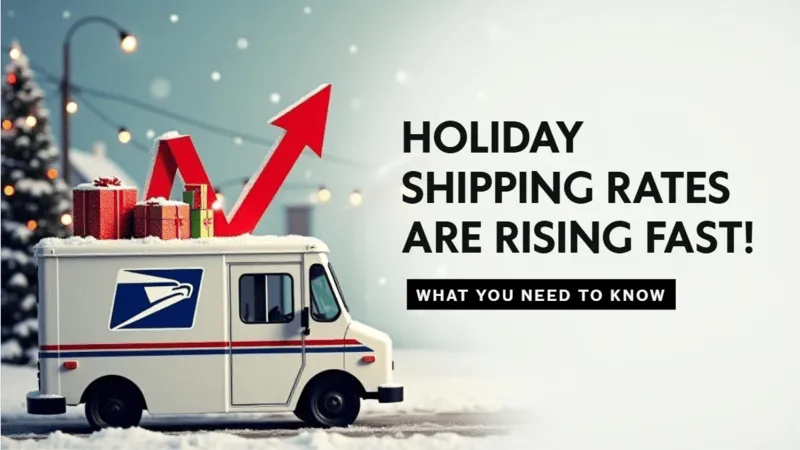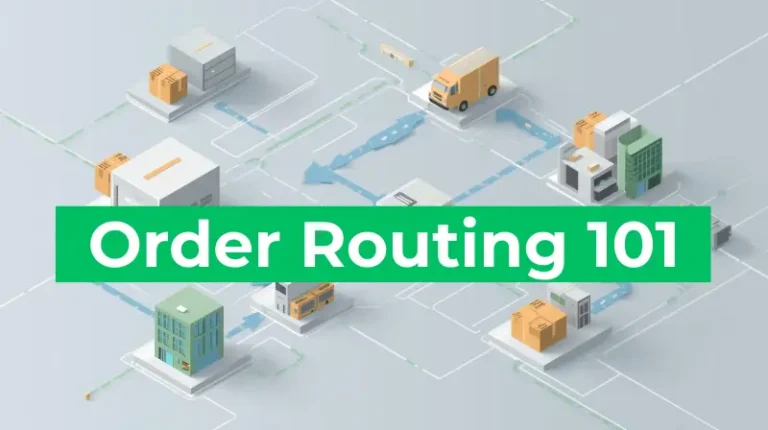How to Manage USPS Peak Season 2025 Rate Hikes and Protect Margins

Last updated on August 13, 2025

In this article
 10 minutes
10 minutes
Brace yourselves, USPS is doing it again with a holiday “temporary” rate hike for shipping. As an ecommerce operator, you’ve probably learned to bake these annual USPS surcharges into your peak season planning (even if they still sting). For USPS Peak Season 2025, the Postal Service will levy extra charges on most package shipping services from October 5, 2025 through January 18, 2026 (pending Postal Regulatory Commission approval). That means for the entirety of Q4 and the early January return season, you’ll be paying more for USPS Priority Mail, Priority Mail Express, USPS Ground Advantage, and Parcel Select packages. How much more? On average, about 4% – 6% more per package, according to USPS, roughly a 5.1% surcharge on Ground Advantage and 4.1% on Priority Mail shipments. In practice, the surcharges are flat dollar amounts by weight and zone. A lightweight local package might only cost an extra $0.30 to $0.40 (for commercial vs. retail customers), but a heavier box going cross-country could see around a $6 – $7 hike. And if you’re shipping big stuff via Priority Mail Express, brace for up to a $16 increase on the heaviest long-distance parcels. In short, every domestic parcel shipped with the Postal Service during the holidays will cost more, with the exact pain determined by package weight and distance.
USPS isn’t doing this just for fun; they have their reasons (even if we don’t love it). The Postal Service says the temporary price change is needed to cover extra handling costs and to keep its rates in line with private competitors during the holiday surge. Essentially, UPS and FedEx slap peak surcharges on shippers each year, and USPS doesn’t want to leave money on the table. In the USPS press release, they explicitly stated that this peak pricing aligns with “competitive practices” and is part of their Delivering for America plan to restore financial stability. And boy, does USPS need the money; they reported a $3.1 billion loss in the quarter leading up to this announcement. Rising costs and lower mail volumes have put them deep in the red, so hiking package rates is one way to claw back revenue. It’s worth noting that these holiday surcharges have become a yearly tradition since 2020 (with a brief pause in 2023). Even though USPS calls them “temporary,” often some of that increase sticks around or gets baked into the next general rate increase. As a longtime fulfillment provider, I’ve seen those postage costs ratchet up year after year. So while USPS wants a successful peak season operationally, they also want to make sure we shippers are sharing the burden of all those extra trucks, overtime hours, and elf hats (okay, maybe not the hats) that come with the holidays.
Slash Your Fulfillment Costs by Up to 30%
Cut shipping expenses by 30% and boost profit with Cahoot's AI-optimized fulfillment services and modern tech —no overheads and no humans required!
I'm Interested in Saving Time and MoneyImpact on Ecommerce Sellers and Shippers
So, what does this mean for those of us sending out tons of packages during the holidays? In a nutshell: higher shipping costs and tighter margins. If you offer “free shipping” to customers, these surcharges eat directly into your profit per order. For example, if you normally spend $8 to ship a medium parcel and now it’s $9, that dollar is coming out of your bottom line unless you adjust prices. For merchants who charge customers for shipping, there’s a decision to make: do you raise your rates at checkout to pass on these extra fees? You might have to, especially on heavy items where an extra $5 – $7 is non-trivial. The challenge is doing so without scaring off potential customers. Holiday shoppers are price-sensitive, and a sudden jump in shipping costs could lead to cart abandonment. It’s a delicate balance.
Marketplace sellers face an extra wrinkle: platforms like eBay and Etsy charge their commission (final value fee) on the total transaction, including shipping. That means whenever USPS raises shipping rates, marketplaces get an automatic fee boost from your higher shipping charge. Ouch. It’s like a tax on top of a tax. For eBay sales, I know that a $0.50 postage increase might only marginally affect buyers, but it will also slightly increase the fee eBay takes. Multiply that across hundreds of orders, and it adds up. Postal Service surcharges can also influence shipping strategy. Some sellers might shift more volume to UPS or FedEx if those carriers turn out cheaper for certain weights, though keep in mind UPS and FedEx have their own peak surcharges (often targeted at large volume shippers or oversized packages) rather than a blanket increase on all parcels. So definitely compare rates on a case-by-case basis. Sometimes USPS will still be the most cost-effective even with the surcharge, especially for light packages and/or short distances. But for heavy boxes or Zone 8 shipments, UPS Ground might beat USPS Ground Advantage this year, depending on negotiated rates.
One often overlooked impact: package weight and dimensions optimization. With these flat surcharges kicking in at weight breakpoints, it’s a good reminder to optimize packaging. If you can reduce a package’s weight below 11 lbs (where a big jump occurs) or keep it in a lower zone by shipping from a closer warehouse, you should. For instance, the surcharge for a Ground Advantage package 0 – 3 lbs going far (Zones 5 – 9) is $0.50, but 4 – 10 lbs is $1.00. That’s double. If you can shave a pound or two off through smarter packing or split shipments by region to use nearer fulfillment centers, you can save that $0.50 per package. Over thousands of orders, it matters. This is where having a fulfillment partner like Cahoot with a nationwide network helps; you can forward-position inventory so that most customers are in Zones 1 – 4, where surcharges are much lower (e.g., $0.40 instead of $0.90 for a small parcel). It’s a strategy of “ship shorter distances” to mitigate costs. And you can quickly scale outsourced fulfillment up or down to match your real-time demand.
Looking for a New 3PL? Start with this Free RFP Template
Cut weeks off your selection process. Avoid pitfalls. Get the only 3PL RFP checklist built for ecommerce brands, absolutely free.
Get My Free 3PL RFPStrategies to Mitigate the Surcharge Surge
We can’t avoid the USPS hikes, but we can get creative to lessen the impact. Here are a few tactics either we (Cahoot) or our clients are using and recommending this peak season:
- Plan Pricing and Promotions Thoughtfully: Knowing shipping will cost more, consider adjusting your pricing or promo strategy. This might mean raising product prices a tad or setting a higher free shipping threshold to cover the difference. Alternatively, you could run a holiday sale on items but make it conditional on buying two or more units, that way you get more revenue per shipment (and effectively dilute the shipping cost per item).
- Use Multiple Carriers: Rate-shop every order through your shipping software. If UPS or FedEx can deliver a package cheaper (accounting for their surcharges too), use them. USPS is often best for small parcels, but as weight increases, the calculus can change. Having all three major carriers enabled offers flexibility. And don’t forget regional carriers; they sometimes don’t add surcharges or have lower base rates for nearby zones.
- Optimize Packing: This is a great time to review packaging. Can you use a smaller box or poly mailer to reduce dimensional weight? Can you remove unnecessary packing weight (without compromising product safety)? Even a few ounces off might keep you in a lower weight tier for the surcharge. Also, if you sell bundles, see if splitting into two lighter shipments (to avoid a heavy surcharge band) makes sense cost-wise, or vice versa, combining items to ship fewer packages.
- Leverage Fulfillment Centers in Strategic Locations: As mentioned, if you have the capability to ship from multiple warehouses, do it. The shorter the distance a package travels, the lower the zone and usually the lower the surcharge. My company Cahoot, for instance, places inventory in different regions, so an order to California ships from our West Coast node, arriving faster and incurring, say, a Zone 2 or 3 surcharge (just cents) instead of Zone 8 ($$$). If you’re FBA-only, you can’t control from which warehouse Amazon ships each order, but for your own site orders or Seller Fulfilled Prime, consider a fulfillment partner or 3PL network to distribute inventory.
- Communicate with Customers: This might not reduce costs, but it can preserve trust. If you do have to increase shipping fees or product prices due to carrier rates, be transparent. Customers remember how a company handles things during the crunch. A small note like “Due to seasonal USPS postage increases, our shipping rates will be slightly higher from Oct–Jan” can help manage expectations. Some sellers even encourage customers to order before a certain date to “beat the holiday shipping rush,” indirectly getting them to purchase early, before surcharges kick in on October 5.
Lastly, don’t forget that these surcharges will end (at least this round). Come mid-January, rates should revert to normal (or whatever the new normal is after any general increases). I always mark my calendar for the end date so I can monitor the new state of things. But I won’t be shocked if USPS announces that, say, certain “temporary” increases will roll into a permanent rate hike soon after. It’s happened before. The Postal Service knows that once we adjust to paying a bit more, we barely notice when it becomes the new baseline. Cynicism aside, the best approach is to adapt and control what we can. By optimizing our shipping processes and maybe tightening our belt elsewhere during peak, we can absorb this hit. After all, everyone is facing the same USPS surcharges, so in a way it’s a level playing field. If you manage them smarter than the next guy, that becomes a competitive advantage.
Bottom Line
The USPS peak season rate hike is a headache, but it’s not a show-stopper. As a shipper, treat it as a cost of doing holiday business and use it as motivation to streamline everything you can. And when you see those mail trucks hauling away your piles of Q4 orders, it’s okay to grumble a little about the extra fees, but then get back to work making sure your customers get their packages on time. Happy (expensive) holidays!
Scale Faster with the World’s First Peer-to-Peer Fulfillment Network
Tap into a nationwide network of high-performance partner warehouses — expand capacity, cut shipping costs, and reach customers 1–2 days faster.
Explore Fulfillment NetworkFrequently Asked Questions
When will the USPS peak season 2025 temporary price change take effect?
The Postal Service will apply temporary price changes from October 5, 2025, through January 18, 2026, pending Postal Regulatory Commission review, affecting multiple package shipping services.
Which USPS services are affected by the 2025 peak season rate hikes?
Priority Mail, Priority Mail Express, USPS Ground Advantage, and Parcel Select will all see surcharges, impacting commercial domestic competitive parcels and package services by weight and zone.
Why is the Postal Service raising rates for peak season 2025?
USPS says the temporary price change is needed to cover extra handling costs during high-volume periods and to keep rates in line with competitive practices used by other major carriers.
How much will USPS peak season 2025 surcharges cost shippers?
Surcharges range from around $0.30 for lightweight local USPS Ground Advantage parcels to as much as $16 for heavy Priority Mail Express shipments traveling long distances.
How can ecommerce sellers reduce the impact of USPS peak season rate hikes?
Sellers can optimize package weight, forward-position inventory to lower zones, use multiple carriers for package shipping services, and adjust pricing to cover extra handling costs while maintaining a successful peak season.

Turn Returns Into New Revenue





